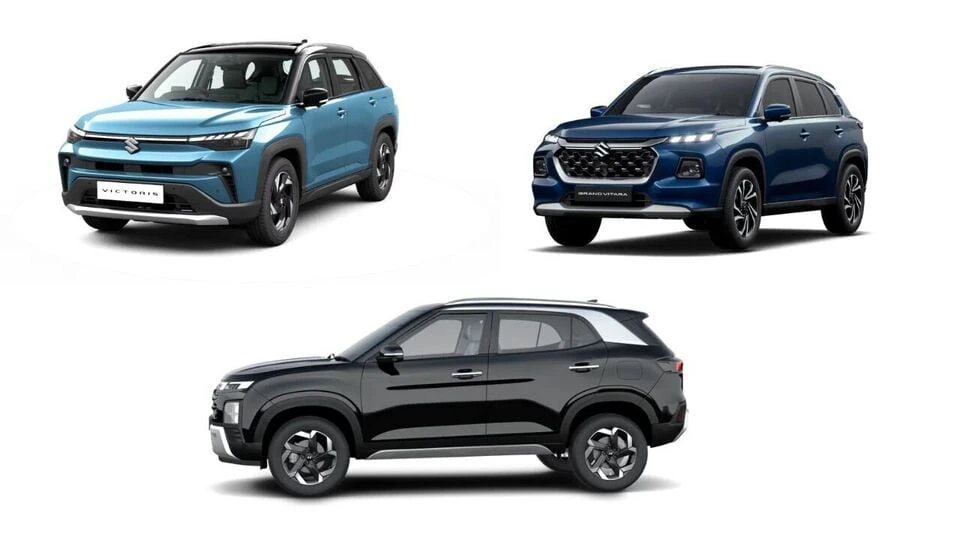The Maruti Suzuki Victoris is the latest entry from the Indian manufacturer that joins the ranks of compact SUVs on our shores. Priced from ₹ 10.50 lakh (ex-showroom), it is positioned as the flagship model in Maruti’s Arena network.
With its launch, Maruti aims to bridge the gap between the Brezza and Grand Vitara while targeting a new generation of buyers who expect strong technology and safety credentials. The Victoris takes direct aim at the Hyundai Creta, which remains a benchmark in the segment, and the Grand Vitara, its premium counterpart from the Nexa channel. Each SUV now caters to slightly overlapping audiences, making this an ideal time to examine how they stack up on price, features, and specifications.
Hyundai Creta vs Maruti Victoris vs Grand Vitara: Price
Maruti Suzuki has been deliberate in positioning the Victoris aggressively. With prices starting at ₹10.50 lakh and rising to ₹19.99 lakh for the top-spec strong hybrid, it undercuts not just key rivals but also its own stablemate, the Grand Vitara, in comparable trims. The difference between these trims can go a little over ₹90,000, a gap that will not go unnoticed by buyers seeking a feature-loaded SUV under ₹20 lakh. The Creta, in contrast, begins at ₹10.72 lakh (ex-showroom) but stretches further up the ladder, with turbo-petrol and diesel trims pushing the top end beyond ₹20 lakh and nearing ₹24 lakh for the most feature-rich versions.
That wider spread means Hyundai continues to cover a broader range of buyers, while Maruti focuses on offering premium features at a lower price ceiling. Between the two Maruti SUVs, the Victoris is clearly the more budget-conscious yet well-equipped option, while the Grand Vitara maintains its premium positioning in the Nexa network.
(Also GST cut fuels Maruti Suzuki’s best festive season in a decade)
Creta vs Victoris vs Grand Vitara: Features
The Victoris strongly prioritises its tech and safety suite, with six airbags as standard, a 360-degree camera, and Level 2 ADAS available on higher trims. The addition of a gesture-controlled powered tailgate, 64-colour ambient lighting, a 10.25-inch digital cockpit, and a Dolby Atmos-equipped Infinity audio system helps it stand out as the more modern cabin of the three.
The Grand Vitara brings a more premium approach rather than outright novelty. It offers features such as ventilated seats, a panoramic sunroof, wireless charging, and connected car technology, but misses out on the ADAS for now. While it is not as modern as the Victoris’ cabin, the Grand Vitara is still a familiar name among a big circle of buyers who know how it performs in the real world.
The Creta remains one of the most balanced packages on the tech front. Its mid to top trims include ADAS, dual-zone climate control, ventilated seats, a panoramic sunroof, and a Bose audio system. Hyundai’s advantage lies in its variant spread, enabling customers to opt for select features without having to go all the way up the range. Here, the Victoris offers the most tech-forward feature set for the money, while the Creta delivers the widest configurability. The Grand Vitara continues to cater to those seeking refinement and familiarity.
Creta vs Victoris vs Grand Vitara: Specifications
The Victoris and the Grand Vitara share their underpinnings and, as such, offer the same powertrain options. Both are sold with 1.5-litre petrol engines, which can be had in mild-hybrid and strong-hybrid versions, with select trims offering Suzuki’s AllGrip Select AWD system. Power figures are also similar, with the mild hybrids making 102 bhp and the strong hybrids delivering a combined 114 bhp. Maruti further offers CNG variants for those looking to reduce running costs.
In contrast, the Hyundai Creta continues to offer conventional engines. It offers a 1.5-litre petrol, a 1.5-litre diesel, and a 1.5-litre turbo-petrol for those prioritising performance. Power figures vary from 113 bhp in the standard petrol to 158 bhp in the turbocharged variants. Transmission options include manual, IVT, torque converter, and DCT, depending on the engine. However, it lacks an AWD option, aligning it more with urban buyers than those seeking off-road capability.
Among the three, the Hyundai Creta remains the most established option, offering diesel, turbo, and feature-rich trims that span a broad price spectrum. The Grand Vitara, as the Nexa product, focuses on offering a premium experience with reliability backed by a strong service network. Here, the Victoris undercuts its rivals on price while introducing the strongest mix of features and engine options.
Ultimately, those who prioritise reliability, efficiency, and a compelling tech suite can find the Victoris to be the most suitable option. The Grand Vitara is its more refined sibling, and while it is not as tech-laden, its brand familiarity continues to resonate among Indian buyers. The Creta, on the other hand, is the most premium of the lot, with stronger performance credentials and a premium interior experience.
